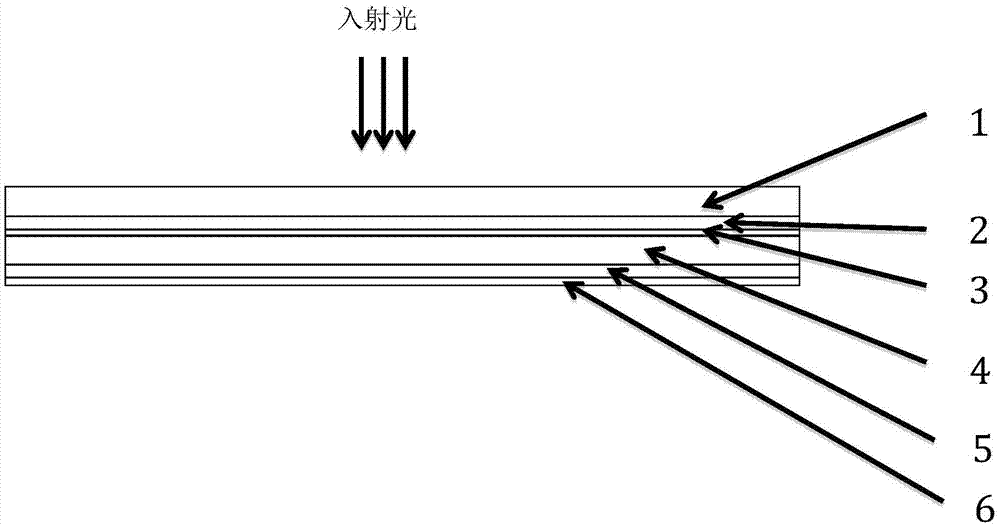Thin film crystalline silicon perovskite heterojunction solar cell and preparation method thereof
A solar cell and perovskite technology, applied in circuits, photovoltaic power generation, electrical components, etc., can solve the performance limitations of solar cell devices such as open circuit voltage, battery efficiency decline, short circuit between perovskite layer and conductive substrate, etc.
- Summary
- Abstract
- Description
- Claims
- Application Information
AI Technical Summary
Problems solved by technology
Method used
Image
Examples
Embodiment 1
[0064] A method for preparing a thin-film crystalline silicon perovskite heterojunction solar cell according to this embodiment, the steps are as follows:
[0065] The first step is to prepare a P-type thin film crystalline silicon layer on the transparent conductive substrate of the AZO transparent oxide conductive layer based on glass:
[0066] (1.1) Preparation of P-type α-Si:H amorphous silicon thin film: Place the transparent conductive substrate of AZO based on glass on the sample stage of PECVD equipment, and use the PECVD method at a reaction pressure of 5Pa, a substrate temperature of 50°C, SiH 4 The gas flow rate is 0.lsccm, H 2 Gas flow rate is 1sccm, PH 3 Under the condition that the gas flow is 0.000lsccm, a 20nm thick P-type α-Si:H amorphous silicon film is grown on the transparent conductive substrate of the AZO transparent oxide conductive layer based on glass,
[0067] (1.2) Dehydrogenation of P-type α-Si:H amorphous silicon thin film: in high-purity N 2 A...
Embodiment 2
[0088] A method for preparing a thin-film crystalline silicon perovskite heterojunction solar cell according to this embodiment, the steps are as follows:
[0089] The first step is to prepare a P-type thin film crystalline silicon layer on the transparent conductive substrate of the ITO transparent oxide conductive layer based on glass:
[0090] (1.1) Preparation of P-type α-Si:H amorphous silicon thin film: Place the transparent conductive substrate on the sample stage of PECVD equipment, and through the PECVD method, at a reaction pressure of 26Pa, a substrate temperature of 200°C, SiH 4 The gas flow rate is 5 sccm, H 2 Gas flow rate is 50sccm, PH 3 Under the condition that the gas flow is 0.5 sccm, a 1510nm thick P-type α-Si:H amorphous silicon film is grown on the transparent conductive substrate of the ITO transparent oxide conductive layer based on glass,
[0091] (1.2) Dehydrogenation of P-type α-Si:H amorphous silicon thin film: in high-purity N 2 The P-type α-Si:H...
Embodiment 3
[0112] A method for preparing a thin-film crystalline silicon perovskite heterojunction solar cell according to this embodiment, the steps are as follows:
[0113] The first step is to prepare a P-type thin film crystalline silicon layer on the transparent conductive substrate of the FTO transparent oxide conductive layer based on glass:
[0114] (1.1) Preparation of P-type α-Si:H amorphous silicon thin film: Place the transparent conductive substrate on the sample stage of PECVD equipment, and through PECVD method, under the reaction pressure of 50Pa, substrate temperature of 350℃, SiH 4 Gas flow rate is 10sccm, H 2 Gas flow is l00sccm, PH 3 Under the condition that the gas flow is 1 sccm, a 3000nm thick P-type α-Si:H amorphous silicon film is grown on the transparent conductive substrate of the FTO transparent oxide conductive layer based on glass,
[0115] (1.2) Dehydrogenation of P-type α-Si:H amorphous silicon thin film: in high-purity N 2 The P-type α-Si:H amorphous s...
PUM
| Property | Measurement | Unit |
|---|---|---|
| thickness | aaaaa | aaaaa |
| thickness | aaaaa | aaaaa |
| thickness | aaaaa | aaaaa |
Abstract
Description
Claims
Application Information
 Login to View More
Login to View More - R&D
- Intellectual Property
- Life Sciences
- Materials
- Tech Scout
- Unparalleled Data Quality
- Higher Quality Content
- 60% Fewer Hallucinations
Browse by: Latest US Patents, China's latest patents, Technical Efficacy Thesaurus, Application Domain, Technology Topic, Popular Technical Reports.
© 2025 PatSnap. All rights reserved.Legal|Privacy policy|Modern Slavery Act Transparency Statement|Sitemap|About US| Contact US: help@patsnap.com

